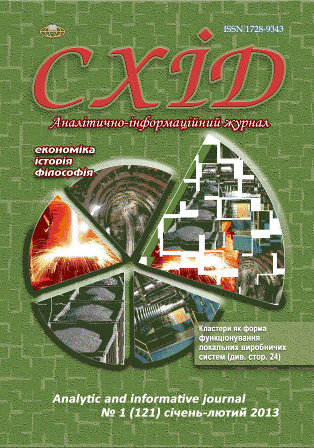The articulation of the sacred attitude to nature
DOI:
https://doi.org/10.21847/1728-9343.2013.1(121).13430Keywords:
nature, sacred, profane, holy, religious, sacral, votive objectsAbstract
A man lives in natural environment and considers it the primordial of his being on the Earth. But depending on the nature causes terrible feeling. It is the state that is caused by sacral things.
Sacral things have ambiguous meaning in philosophical literature; it is different from "religious", "dark", "spiritual". Such terms can be synonyms and they have to be differentiated. Indistinct content of term "sacral" enables to use it for any natural landscapes, manmade constructions.
Man's existence itself is soaked with sacral value as archaic person schematize the Universe, his behavior attitude to nature. It oversteps religion which is a certain systematizer as well.
It is impossible to go beyond sacral for it covers everything.
To be revealed in nature a religious person has to be soaked with sacral. At the same time the man with sacral feelings transposes his attitude to the places determined individually as unusual.
Religion applies term sacral to its myths. But it forgets that religion can disappear , but not a sacral thing.
Religion uses such terms, which are those among sacral features.
People settle spontaneously based on natural-biological needs and colonization principle does not rely on religious views, on the contrary, a man gives the places regarded as outstanding ones supernatural features.
A man chose places for settling with favourable conditions and imparted unusual traits for them. Worship sites were divided into sacral ones and those bearing political-ideological role.
At the same time sacral symbol has got exoteric and esoteric sense; it covers and uncovers spiritual aspect. But what cover-up do they mean when God himself has changed into simulator during post-modern times?
Contradistinction process of "spiritual", "heavenly", "secular" has originated from monotheistic religions that have resulted in secularization and desacralization afterwards.
When studying natural worship places you need to consider more ethically terms "sacral", "spiritual", "religious".
Downloads
References
Бенуа А. де. Путь к сакральному [Електронний ресурс] / Ален де Бенуа. - Париж : Альбин Миттель, 1981. - Режим доступу : http:// seidr/woods.ru/benua.htm.
Труссон П. Сакральное и мир [Електронний ресурс] / Патрик Труссон ; [пер. В. Ванюшкиной]. - Режим доступу : http:// nationalism/ org/vvv/ trasson-sacral.and.myth.htm.
Каюа Р. Людина та сакральне / Роже Каюа ; [пер. з фр.] - К. : Ваклер, 2003. - 256 с.
Элиаде М. Cвященное и мирское / Мирча Элиаде ; [пер. с фр., предисл. и коммент. Н. К. Гарбовского]. - М. : Изд-во МГУ, 1994. - 144 с.
Суханцева В. К. Сакральное в обыденном сознании / В. К. Суханцева // Філософські дослідження : зб. наук. праць. - 2008. - № 9. - С. 6-9.
Огудин В. Л. Сакральное и экология. Формы реалигиозно-экологического мировоззрения / В. Л. Огудин. - К. : Киевский эколого-культурный центр, 2003. - 752 с.
Кобылкин Д. С. Сакральное и десакральное в эстетическом аспекте / Д. С. Кобылкин // Філософські дослідження : зб. наук. праць. - 2008. - № 9. - С. 11-18.
Ильченко В. И. Феномен сакрального в историко-культурном пространстве / В. Ильченко, В. Шелюто. - К. : АО "ИТН", 2002. - 325 с.
Alen de Benua (1981), Put k sakralnomu, Paris, available at: http:// seidr/woods.ru/benua.htm.
Trusson Patrik, Sakralnoye i mir, translated by V. Vanyush¬kina, available at: http:// nationalism/ org/vvv/ trasson-sacral. and.myth.htm.
Kaiua R. (2003), Liudyna ta sakralne, Vakler, Kyiv, 256 р.
Mircha Eliade (1994), Cvyashchennoe i mirskoye, Moscow, 144 р.
Sukhantseva V. K. (2008), Filosofski doslidzhennia, zbirnyk naukovykh prats, No. 9, рр. 6-9.
Ogudin V. L. (2003), Sakralnoye i ekologiya. Formy reali¬giozno-ekologicheskogo mirovozzreniya, Kyiv, 752 р.
Kobylkin D. S. (2008), Filosofski doslidzhennia, zbirnyk naukovykh prats, No. 9, рр. 11-18.
Ilchenko V. I. (2002), Fenomen sakralnogo v istoriko-kulturnom prostranstve, Kyiv, 325 р.
Downloads
Published
How to Cite
Issue
Section
License
Copyright (c) 2013 Valentyna Paterykina

This work is licensed under a Creative Commons Attribution-NonCommercial-NoDerivatives 4.0 International License.
1. Authors bear responsibility for the accuracy of facts, quotations, numbers and names used.
2. Manuscripts are not sent back.
3. The publisher does not always agree with the authors' opinion.
4. The authors reserve the right to authorship of the work and pass the first publication right of this work to the journal under the terms of a Creative Commons Attribution-NonCommercial-NoDerivatives 4.0 International License. This license allows others to distribute (copy) the published work for non-commercial purposes, provided there is mandatory attribution to its authors and a link to the first publication in our journal.
5. The authors have the right to conclude separate supplement agreements that relate to non-exclusive work distribution in the form in which it has been published by the journal (for example, to upload the work to the online storage of the journal or publish it as part of a monograph), provided that the reference to the first publication of the work in this journal is included.

